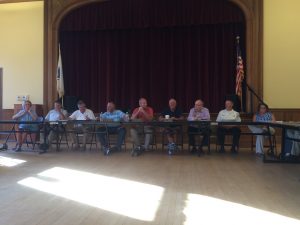Nearly 30 members of what Marion Selectmen Chairman Jody Dickerson called “Team Marion” met with the Marion Board of Selectmen on June 30 for a quarterly review of departmental budgets with department heads on the eve of the new fiscal year.
Everyone from the tree warden to the Capital Planning Committee, the town administrator to the school superintendent, paid employees to those who volunteer their talents and expertise, shared brief sketches highlighting FY2016 successes, unfinished business, and FY2017 plans.
Finance Director Judy Moody said everyone had done well working within budgets, and she discussed a few expenses that would become encumbrances to the new budget. She said that it would take a couple of weeks to finalize the FY16 books, including any turn-backs, but that overall everything was on track.
Those department heads responsible for municipal buildings such as ORR School Superintendent Doug White, Harbormaster Isaac Perry, Police Chief Lincoln Miller, and Fire Chief Brian Jackvony, all said that only normal maintenance expenses were planned for the coming year.
However, when it came to Facilities Manager Shaun Cormier, he said that due to staffing issues, with only a few part-time seasonal workers, his department was about four months behind schedule. In spite of that reality, he listed a number of pending projects: roof repairs at the Atlantis Drive building; fire station windows; library roof replacements; and work on buildings at Washburn Park.
“Don’t know how much we’re going to get done, though,” he said, concluding his comments.
Department of Public Works Superintendent Rob Zora talked about the wastewater NPDES permit in relationship to its impact on road improvement projects.
“We’ve been held hostage,” said Zora. He said he was “discouraged” after meeting with state officials regarding the matter of Marion’s wastewater discharge permit. Zora said he thought progress had been made in discussing the problem of meeting state requirements, but that upon receipt of the DEP/EPA consent order that was no longer the case.
“Once you accept the consent order, you lose your right to appeal,” Zora said. “This will be a long uphill battle to make them listen to sound science.”
Due to the unknown financial impact of having to meet the NPDES permit conditions, which he indicated in a follow-up conversation would cost many millions of dollars, other capital improvements could not move forward.
On the water side of public works, Zora said the annual water restriction from June 15 to September 15 was now in place. He also said that state water restrictions were heading to all cities and towns in the near future. Annual water restrictions are nothing new to Marion residents, he said, noting, “The public has worked well with restrictions.”
Around the table, other matters were aired.
Perry said of the harbormaster’s office, “There are three full-time employees and five part-timers working in a fifteen- by fifteen-foot space.” He said his capital plans include expanding the office area to include space above the public restrooms. Perry also said that a new pump-out boat was on his planning horizon, but that grant monies would assist with that expense.
Gary Carreiro, town treasurer, said collectibles were running about 98% while also saying, “A lot of people in town are struggling to pay bills…. We see it everyday.” He noted that the recent vote in Britain to pull out of the European Union was affecting the town’s financial investments.
When the issue of the town house came up, Priscilla Ditchfield of the Town House Committee said, “Three-hundred and fifteen-thousand dollars is being used for the architects to prepare design drawings,” in advance of the Fall Town Meeting. She said the process includes providing voters with cost estimates for rehabilitation construction of the historical structure for the annual town meeting and then firm construction costs for the spring town meeting.
Ditchfield said that the committee was in its fifth year of researching and refining the plan saying, “We’ve spent a lot of time to come up with the most feasible plan possible.”
When asked, she said that presently the plan would cost each household about $180 per year for 20 years but that borrowing against CPA funds was not out of the question.
Building Commissioner Scott Shippey said there was new growth in town; his office had recorded 350 building permits last year with roughly 10% of those being for new construction. He said he is looking into streamlining the permitting process with online tools in the future.
Jackvony said of the Fire Department that new radios, new ice suits, new employees, and new fire engines were all in the works. Turning to Mooney, he said he had a list of encumbrances for her, to which she responded, “Get them to me today.” He also said a new ventilation system is planned for the fire station, as well as a new drier for turn-out gear.
Finance Committee Chairman Alan Minard told the group, “It makes so much more sense to use the money more smoothly versus big flurries of spending.” He continued, “Think about how you look at your business,” saying that department heads should work financials from the bottom up rather than his committee having to “find the fluff in your budgets.”
Capital Planning Committee Chairman Paul Naiman asked, “What can we do to help you plan better?”
In a matter not directly related to the town’s present finance issues, Conservation Commission Chairman Norm Hills said that new FEMA flood lines included a category titled “coastal zone A.” Hills said that this new designation would affect vast swathes of property in Marion. Shippey said that, although it’s not in the building code today, it was something that would “impact a lot of people.”
Dickerson thanked everyone and said that moving forward, quarterly all-inclusive meetings would help with the communication between departments and town boards and committees.
By Marilou Newell
